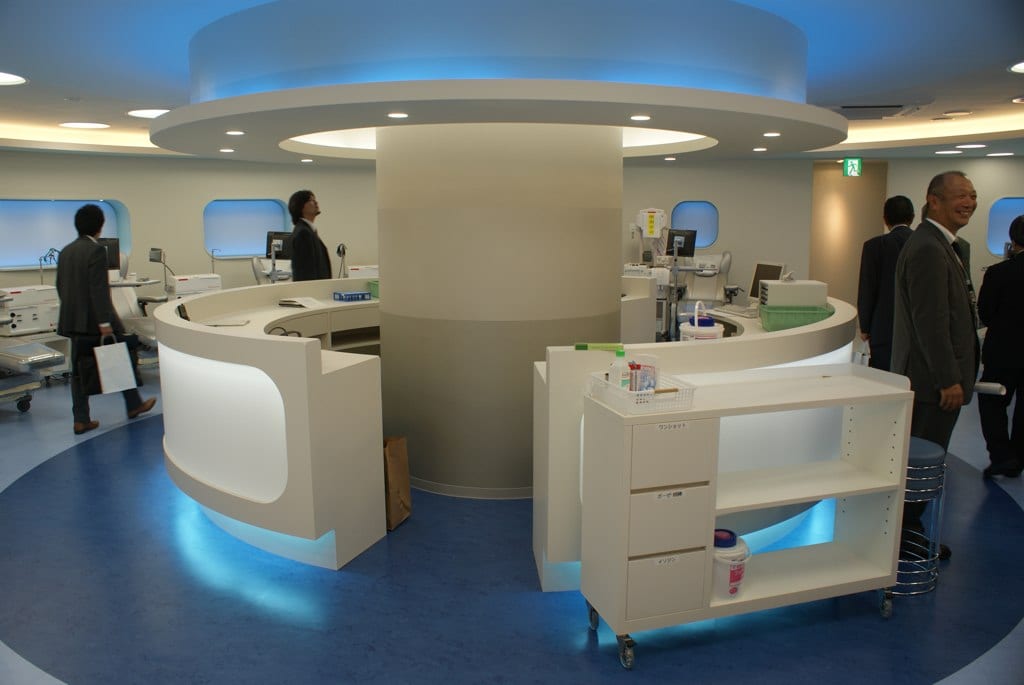
Does employee engagement affect RoI in the healthcare industry?
Don’t confuse employee satisfaction with real engagement
“Without employee engagement, you’re never going to get the kind of ultimate patient experience you’re hoping for.” –Mike Packnett, CEO, Parkview Health
Managers in all industries want to know how to get the best out of their employees, while at the same time maintaining their health, wellbeing and safety. Since we know that that job satisfaction, organizational commitment, turnover intentions, and physical and mental wellbeing of employees are predictors of key organizational outcomes such as effectiveness, productivity and innovation means there are many reasons to encourage such positive employee attitudes. This applies even more so in healthcare, where the attitudes of employees are likely to directly affect the quality of the patient experience.
People-intensive
Despite all the technological advances in medicine and medical practice; healthcare industry is still a people-intensive business. Many healthcare leaders get confused when they try to link “employee engagement” to making staff satisfied or even happy. Unfortunately, as a result of this confusion, hospital management tend to under-invest (in terms of money and time) in engagement initiatives, thinking engagement is “nice to have” rather than an enabler of their most important strategic goals.
The real problem in “satisfying employees” is that it leads to setting the bar too low. For example, a “satisfied” nurse might show up for his/her shift without complaint, and do the minimum required, and be very satisfied. At the same time, nurse will be satisfied as he/she takes the job from the competing hospital in the next town over for a slightly better schedule/salary (or both). In brief, employee happiness or “satisfaction” means that someone might be happy or satisfied at work, but that doesn’t necessarily mean they are working productively on behalf of the hospital or mindful of patient needs.
What is engagement?
The term engagement has been used to refer to
- a psychological state (e.g., involvement, commitment, attachment, mood)
- a performance construct (e.g., either effort or observable behavior, including pro-social and organizational citizenship behavior)
- a disposition (e.g., positive affect),
or some combination of these.
Over the years, researchers have measured employee engagement by using three different approaches: as a description of conditions under which people work, as a behavioral outcome, and as a psychological orientation. It is this latter approach to engagement which is the most common in academic research to date.
In 2007, the NHS National Workforce Projects team defined engagement as:
“… a measure of how people connect in their work and feel committed to their organization and its goals. People who are highly engaged in an activity feel excited and enthusiastic about their role, say time passes quickly at work, devote extra effort to the activity, identify with the task and describe themselves to others in the context of their task (doctor, nurse, NHS manager), think about the questions or challenges posed by the activity during their spare moments (for example when travelling to and from work), resist distractions, find it easy to stay focused and invite others into the activity or organization (their enthusiasm is contagious)”. (NHS National Workforce Projects 2007)
Employee Engagement is the emotional commitment employees have towards the Organization and its goals
Put simply, when your employees are engaged, they care about your hospital, their team and their patients.
When employees are engaged – when they care – they give discretionary effort. When I ask hospital workers in any department how they can “see” signs of discretionary effort, the examples are endless:
- The engaged hospital worker who makes eye contact with all visitors and escorts lost family members to their destination
- The engaged care givers who never forget to wash their hands or check IV lines
- The engaged worker who notices the yellow “fall risk” bracelet on a patient in the lobby and helps her back to her room
- The engaged care givers who listen, unrushed, as patients ask about their medications and discharge orders
- The engaged night-shift workers who are mindful of being quiet
- The engaged food service worker who ensures all meals are delivered while still hot
- The engaged nurses who always round on the hour
- Engaged care givers make fewer mistakes with the administration of medications
The quality of patient experience, as measured by inpatient satisfaction in acute trusts in NHS (NHS staff survey 2009-2010), is strongly linked with engagement (as it is with other aspects of staff experience). Patient satisfaction is significantly higher in trusts with higher levels of employee engagement. The main driver for this is the advocacy dimension of engagement, which has by far the highest correlation with patient satisfaction. This may partly reflect the symbiotic nature of staff and patient experience: if staff are aware that patients are largely satisfied with the care provided, they may be more likely to view the quality of care more positively themselves.
According to the 2009 Boorman Review, NHS Staff Health and Well-being (Boorman 2009), NHS staff are absent from work for an average of 10.7 days each year, losing the service a total of 10.3 million days annually and costing a staggering £1.75 billion. Total absenteeism equates to the loss of 45,000 whole-time equivalent staff annually. For this reason, any factors that are linked with absenteeism should be of great importance to NHS managers as they could provide the key to increasing both efficiency and quality.
In addition to that, in trusts where a large percentage of staff felt they could contribute towards improvements at work, infection rates had decreased, reinforcing the value of staff involvement in service improvements and of creating cultures of engagement and innovation. This effect is such that where 10 per cent more staff feel able to make such contributions, there would be on average .057 fewer cases of methicillin-resistant staphylococcus aureus per 10,000 bed days. This may appear to be a small effect but, given the large volume of activity in most acute trusts, this could make a real difference in the occurrence of MRSA infections in hospitals.
In an interesting study done by Dr. Rick Blizzard on the issue of medical errors and its impact on the morbidity & mortality of tens of thousands of patients every year. After running his study across 200 hospitals in United States, he concluded that the nurse engagement is the number one predictor of mortality variation across hospitals. The commitment and emotional involvement of the nurses on staff is even more important than their numbers.
How can we improve employee engagement?
Analysis done on over 10 million workers in 150 countries show that there are three main drivers of engagement:
- Growth—you feel like you are advancing and learning new things
- Recognition—you feel appreciated
- Trust—you trust the organization has a bright future
Gallup reports that over 70 percent of the variance in engagement is tied to the manager. This is a key insight: engagement has very little to do with employee appreciation picnics, compensation or parties. It has everything to do with who your manager is, and how he/she is helping you to grow, to feel appreciated and to trust that the organization has a great future. Below is a summary of some activities that healthcare leaders should do.
Annual Engagement Surveys
- These surveys must run regularly on a yearly basis with accurate measurements, improvement plans and follow-up reviews
- The individual team scores must be given to front-line managers, with the expectation that they will in turn share the results with their teams
- Managers must be trained how to foster growth, recognition and trust, and specific ideas for increasing engagement need to come from the individual teams—from the bottom, up to the top.
Recognition Programs and Talent Management Strategies
Healthcare leaders should invest inknowing their employees’ ideas, innovations and initiatives. Recognition and Rewarding systems should be designed and implemented to attract the individual employees into sharing their views and ideas and “emotionally engage” in the already set goals and targets.
Sharing of new strategies’ impact and value
This one is can be quite tricky. Human nature hates “change” as it leads to a sense of insecurity. Well-executed “Change Management” strategies that involve and engage employees in the company’s new projects really enhance the possibility of success and exceeds ROI. It is important for the employee to see and live the “value” and the positive “impact” of this strategy or project on himself 1st and understand his role and even the “value” of his role into the overall success.
Beyond best practice
It’s possible to look at the three areas summarised above and conclude that there’s nothing new here. These strategies and their link to high performance are clear in healthcare and other people-intensive industries. The fact that customer experience in healthcare is highly variable and overall has not improved suggests to me that we need to make accepted good practice our “next practice” as well.
About Author:
Haytham Soliman is a GMC registered orthopaedics surgeon with more than 10 years of clinical experience, trained in Orthopaedics Surgery with special interest in Sports Medicine. He is an advocate of applying quality control measures, evidence-based medicine and updated clinical research in his practice. He also has 8 years’ business and managerial experience with Bupa Arabia as a Customer Experience Excellence Leader. His expertise includes project management, cost containment strategies, strategic partners’ relations and customer experience excellence protocols. An ex-professional athlete, he has a passion for sports and is currently participating in amateur level triathlon competitions.






Great article Haytham, thanks for posting. It amazes me to see how much of a huge difference there is between an employee who is fully engaged and an employee who is merely satisfied. I look forward to your future posts.
Thanks Nicholas for your comment. Employee engagement is a key success of ANY industry where the “personal” touch matters, so how about healthcare? As mentioned, aim (and invest) for “engaged satisfied” employees and not only “satisfied” ones.